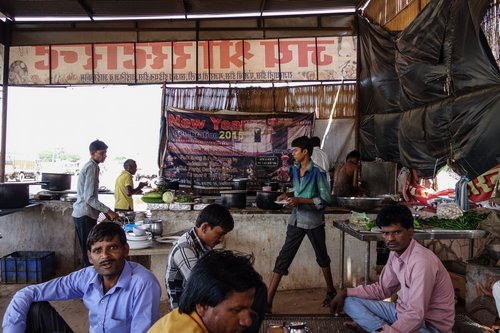We spent much of the day driving towards Bikaner, which was a transit point for us, on the way to Jaisalmer. However, unlike our previous transit town there is actually a fair bit of history and some things to see in Bikaner.
Bikaner is a desert town that was established in 1488 by the son of Jodhpur’s founder, Rao Bika. The city flourished from the 16th century onwards as a staging post for caravan trade routes across the desert.
The most remarkable sight in the city is the magnificent fort, Junargah, which was built between 1589 and 1593 by Raja Rai Singh who was a general in the army of Mughal Emperor Akbar. Unfortunately we arrived at the city after the fort closed for the day so I was only able to take photos from outside of the ticket check-point. The outside walls of the fort are like nothing I’ve seen in India so far.

Two photos from within the main gate, but prior to the ticket check-point:


This being the desert, camels have replaced elephants, horses and mules as the main work animals that you see on the streets:

Overall Bikaner is not as pretty as Jaisalmer but it is fall less touristy so you do not get harassed as much. I understand that if you are looking to book a camel safari, Bikaner would be a better place to book it as you are less likely to get harassed in the process.
The following morning we went to the Karni Mata Rat Temple 30 km south of Bikaner. Karni Mata lived in the 14th century and was reputed to have performed a number of miracles during her lifetime, including bringing her son back from the dead. She subsequently decreed that members of her family would no longer die, but would rather be reincarnated as rats. As such, Hindu worshipers pay their respects to Karni Mata in this temple by feeding and otherwise taking care of the rats in the temple, i.e. her relatives.
I won’t sugar-coat it, the place smells a bit and has quite a bit of rat feces all around as well as the occasional dead rat. There are also plenty of rats around, but they stick mostly to the areas around the walls and corners, so they are easily avoidable. You also have to take your shoes off to enter the temple, but you are allowed to rent slippers for a nominal fee. However, they did run out at some point so as a back-up I would recommend that you bring along a pair of socks that you can throw out after visiting the temple.
Given the smells, I wasn’t at my photographic best here. Sadly, this is the best picture I took showing the entrance to the temple:

Inside the temple:


There was an area by the side where they put out a big milk bowl for the rats. The sight of rats drinking out of the bowl was surprisingly cute:

This is the entrance to the main worshiping structure inside the temple:

A view from the side:

Inside the main structure. The place was packed with people chanting and their worshiping included some use of fire which I was unable to capture because some of the worshipers were giving me the stink-eye when I was photographing the ceremony. As such, I had to keep my pictures fairly discrete:

This is the entrance to the temple as seen from the inside:

Yes the temple was rather stinky and gross, but the decorative elements inside were worth the visit. My favourite feature being the ornate metal doors to the temple as you can see in the third picture below:



A lion at the entrance to the temple. I saw a number of worshipers putting ointments on the lion’s forehead and leaving snacks near its mouth:

To close up this post, I’ll include two photos of a roadside restaurant on our way to Jaisalmer, as I’ve neglected to post pictures of these eateries before. You can tell that the hygiene looks to be questionable, but sometimes eating at these places is unavoidable. I will offer some tips to navigate these eateries. First, make sure that you can see the kitchen. Second, ensure that the people handling the money are not also cooking the food using their hands. And finally, the most important bit, only order fried food that is going to be cooked to hell in front of your eyes. Stuffed naans/parathas are generally pretty safe.

I’ll finish with a picture of the amusing sign for the restaurant:

Increíble, nunca me imagine algo así.
Creo que después de esto ya no tendrás mas sorpresas.
Sigo pendiente de las experiencias de tu viaje.
Estoy en una convención de observadores de aves. Sabes que algunos extranjeros no vinieron por no haber para ellos seguro de gastos médicos que los protejan en caso de alguna enfermedad.
No se si tu viajas con algun tipo de seguro que te proteja contra algún accidente o enfermedad?
Cuidate.
LikeLike